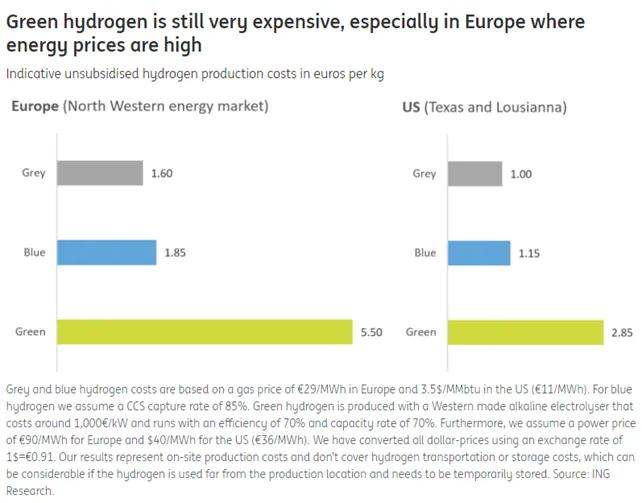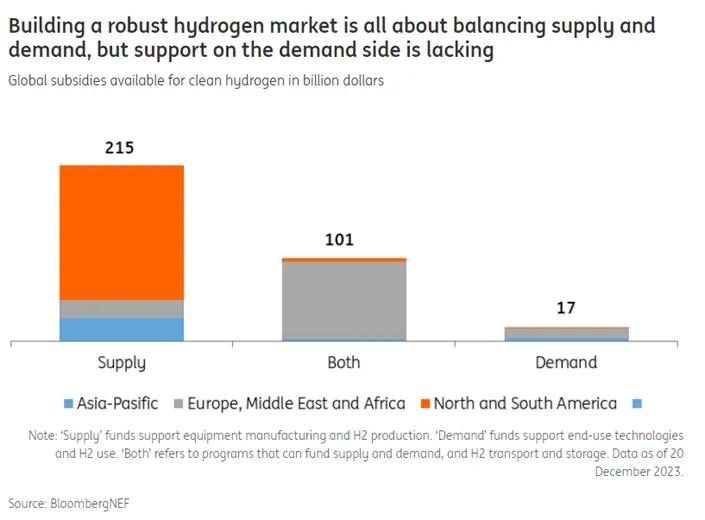What will happen on the hydrogen market in 2024?
28 February 2024
Reading time: 4 min
Hydrogen is considered a versatile energy source and is set to play a key role in the energy transition. At the UN Climate Change Conference in Dubai in 2023, it was decided to continue phasing out fossil fuels. However, renewable energies are often not yet sufficient, especially for energy-intensive industries. In addition, they cannot replace fossil fuels as raw materials for products such as plastic or steel. Hydrogen has therefore been seen as a promising option for some years now, as it can both supply enough energy for high production temperatures and, in combination with hydrocarbons, serve as the basis to produce plastics and steel. After a rather disappointing performance in 2023, the question now is how the market for hydrogen will develop in 2024.
2023 - a disappointing year for hydrogen

Prices for hydrogen - especially green hydrogen - did not fall significantly in 2023. This is mainly due to the fact that investments in announced pilot projects have not been made or have been delayed and the persistently high energy prices in Europe have made the production and transportation of hydrogen even more expensive.
Above all, climate-friendly hydrogen produced from renewable energies is not yet competitive in Europe - compared to CO2-neutral blue or gray hydrogen, which uses natural gas. Even with subsidies of three euros per kilo, green hydrogen would still be more expensive. However, economists expect prices to fall across all types of hydrogen as soon as a global hydrogen market has formed in which consumers benefit from low-cost production regions. At present, the market is still very localized and the formation of a global import and export infrastructure will take some time. It is therefore important that the political framework for a global hydrogen economy is also established in a timely manner.
Outlook 2024

The production and development of a global hydrogen infrastructure is one thing. On the other hand, the question arises as to whether hydrogen will be in demand and used, regardless of how it was produced. If you look at the subsidies, a clear picture emerges. Currently, the supply side in particular benefits greatly from subsidies, while there is hardly any financial support for the demand side. However, this would be needed in order to make investments in the switch from oil and gas-based production to hydrogen. ING economists have calculated that the switch from gas or oil to green hydrogen alone could increase the cost of plastics production in Europe by up to 50 percent. Steel made from green hydrogen could become twice as expensive as coal-based steel, and in shipping or aviation, clean hydrogen-based fuels could be up to ten times more expensive than conventional fossil-based fuels.
A lack of incentives on the demand side could also become a problem for suppliers as soon as they have problems concluding purchase agreements. Projects for the production of hydrogen would thus be burdened with additional risks and investment decisions would ultimately be postponed. This would slow down the expansion of the hydrogen economy, reduce supply and keep prices at a high level.
However, initial efforts are being made to counteract this trend. In the USA, the states of Colorado and Illinois have introduced a subsidy of around one dollar per kilo for users of clean hydrogen, which is aimed in particular at boosting demand for hydrogen in industry.
The European Union is trying to increase demand for clean hydrogen in the coming years with programs such as Opens in a new tab"Fit for 55" and the Opens in a new tabEU Emissions Trading System. In future, users of gray hydrogen will have to replace 42 percent of their hydrogen with green hydrogen. As part of the Opens in a new tabReFuelEU initiative for aviation, 1.2 percent of the fuel supplied to aircraft at EU airports must be hydrogen-based by 2030. And the Opens in a new tabFuelEU Maritime initiative requires shipping companies to reduce their emissions by 2 percent by 2025 and pay a carbon price under the EU Emissions Trading Scheme by 2026, which is already increasing demand for hydrogen-based fuels such as ammonia and methanol.
Overall, more activity is expected on the hydrogen market in 2024. The exact number of projects or additional capacity is less important. Rather, it will be about laying the foundations for future growth, balancing supply and demand and realizing the first success stories that will create further confidence in the market.
You can read the entire outlook for 2024 on our Economics blog:Opens in a new tabhttps://think.ing.com/articles/hold-back-to-reality-paving-the-way-for-future-growth-in-hydrogen
Do you have any questions or comments?
Well, then talk directly to one of our experts!
You liked this article? Then you might also like this one:
Climate change is one of the greatest challenges of our time. The economy must transform its business models into more sustainable and low-emission ones; the financial sector can play an important role in this. As a bank, we want to help align economic growth with environmental and social action.
Climate action at ING
Climate action at ING
There are many reasons for companies to become more sustainable. But regardless of whether it is a question of transforming energy supply, reducing pollutant emissions, or responsibly designing production processes - in the end, a sustainable approach must always be economically feasible. To offer companies an additional incentive, banks like ING have developed a broad toolbox of sustainable financing solutions in recent years.
Sustainable Syndicated Loans: Need for Expertise
Sustainable Syndicated Loans: Need for Expertise